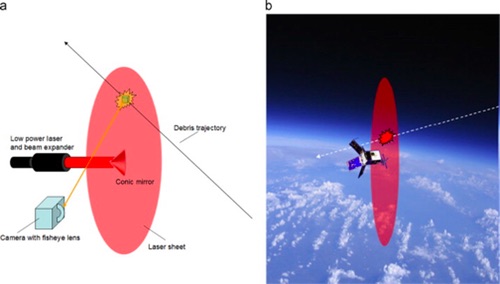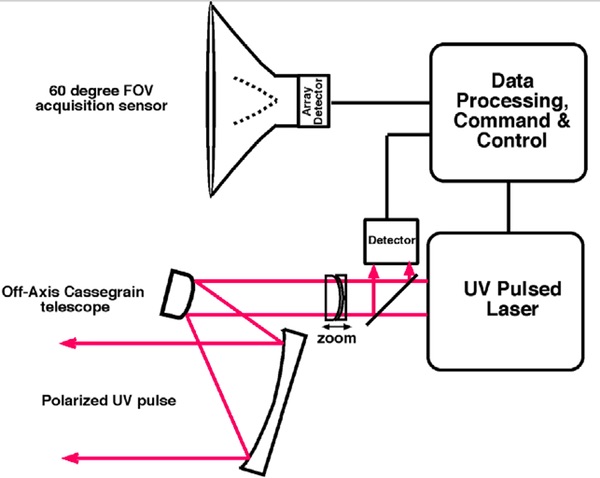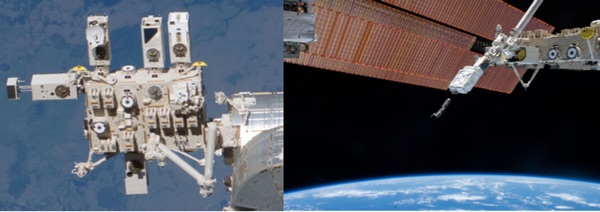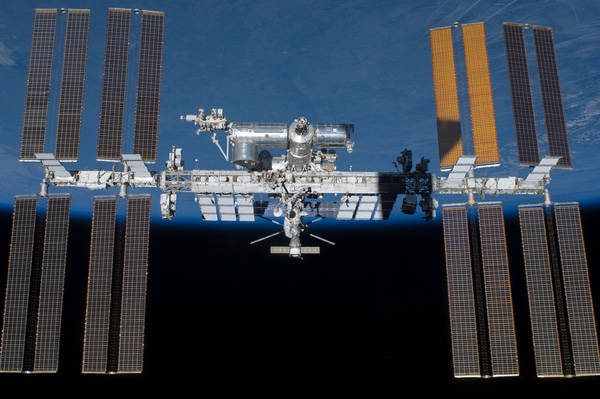A path to a commercial orbital debris cleanup, power-beaming, and communications utility, using technology development missions at the ISSby Al Anzaldua, Gary Barnhard, David Dunlop, and Claude Phipps
|
| Beyond testing power-constrained UV laser systems to protect high-value targets from orbital shrapnel, the ISS, as an international technology development and demonstration lab, could also be a testbed for in-space power beaming and communication technologies. |
Fortunately, there exists a relatively low-cost way to remove this growing threat to the ISS, other spacecraft, and our future space plans. A NASA concept validation study concluded that it is feasible to use power-constrained pulsed lasers to remove virtually all dangerous orbital debris in the range of one to ten centimeters between 400 and 1100 kilometers altitude within two years, and that the cost of doing so would be modest compared to shielding, repairing, or replacing high value spacecraft that would otherwise be lost to small debris impact.2 Moreover, a space-based power-constrained ultraviolet (UV) laser system has special advantages in range, rate of target acquisition, and interaction geometry that drive the estimated cost of removing a single piece of small debris down to less than $1,000.3
Satellites in orbit, including the ISS, represent many billions of dollars of investment. The ISS alone represents a $150-billion investment and years of collaboration by the major spacefaring powers.4 Insurance payouts for satellites becoming disabled on orbit, at least partially because of orbital debris impacts, have already reached $800 million annually.5 Therefore, any relatively low-cost system that can detect, track, and deorbit small, but still dangerous, debris would be of great commercial value.
Beyond testing power-constrained UV laser systems to protect high-value targets from orbital shrapnel, the ISS, as an international technology development and demonstration lab, could also be a testbed for in-space power beaming and communication technologies using power-constrained optical or microwave transmitters. As an international space facility, the ISS can be utilized to transparently demonstrate the feasibility of these new approaches, while also enhancing the safety of the ISS by cleaning approaching debris too small to track through traditional means. Space-to-space power beaming (SSPB) using power-constrained lasers in LEO could be part of a multi-step technology development, demonstration, and deployment mission6 with commercial potential. However, such multi-purpose laser technologies must necessarily be developed off the ISS in stages.
Stage 1: Spotting, tracking, and recording debris trajectories
The Optical Orbital Debris Spotter (OODS) being developed by the Naval Research Lab (NRL) can detect and register debris objects smaller than a grain of rice as they pass through the light sheet it emits. This light sheet can be created using a power-constrained laser. During Stage 1, at least two sufficiently powered OODS could be carried, one each, by free-flying 6U CubeSats outside the ISS “keep out” zone of 200 meters with their laser sheets perpendicular to most of the likely approaching debris. With two OODS thus in train, in the same orbital plane as the ISS, early debris detection and trajectory could be ascertained by ISS equipment and personnel and the parameters fed into a debris removal system using power-constrained UV lasers. Registering and recording debris and debris trajectories not only will aid their subsequent targeting and removal, but will also provide valuable data for future small debris removal efforts. The two OODS units would need sufficient power, and ancillary services (communications, data, navigation, and time) to allow for the detection of one-centimeter or larger debris objects with laser sheets extending out to 500 meters.7
 Figure 1. Optical Orbital Debris Spotter (OODS) developed by the US Naval Research Lab. |
Stage 2: Targeting and deorbiting small debris objects
While a debris trajectory is being ascertained and recorded with OODS systems, precise targeting can be realized by means of the Laser Ablative Debris Removal by Orbital Impulse Transfer (L’ADROIT) system. L’ADROIT is a solar-powered space-based debris removal system consisting of two telescopes connected to a power-constrained UV pulsed laser. One telescope utilizes a wide field of view as a passive acquisition sensor. A second telescope utilizes a narrow field of view for active acquisition. Its firing unit tracks the target, obtains returns from it, focuses on it, and fires repeated 355 nanometer (UV) pulses to alter the target’s orbit.8
 Figure 2. L’ADROIT laser optical debris remover. (credit: Claude Phipps) |
The L’ADROIT system is agile and is estimated to be much less costly than mechanical debris removal technologies. It is the only current approach that can effectively and economically deorbit tumbling debris smaller than ten centimeters in diameter. To deorbit such small shrapnel, L’ADROIT utilizes the third harmonic of a neodymium-doped yttrium aluminum garnet (Nd:YAG) at wavelength 355 nanometers, to deliver 500-joule pulses with a pulse duration of 100 picoseconds. The 500-joule feature enables optics as small as 25 centimeters in diameter. The UV wavelength reduces dazzle of reconnaissance sensors, and aiming the laser roughly head-on into targets (i.e. horizontally from the ISS), rather than up from the ground, also provides much better momentum exchange geometry.9
| An opportunity exists to also test and demonstrate power beaming from the ISS, utilizing a power-constrained optical, W-band, and/or Ka-band microwave transmitter. |
To remove fears that such a UV laser can be used as a weapon, we propose for ISS testbed demonstration, using optical power in the range of 3 to 15 kilowatts to deorbit debris smaller than five centimeters across. Also, such laser tests and demonstrations to protect the ISS must be carried out fully transparently and with the approval of all ISS international partners, as well as the cognizance of all spacefaring nation states and other relevant entities.
Stage 3: Beaming power to free-flying CubeSats
Although the ISS has had to repeatedly move to avoid debris objects and shows multiple small impacts on its exterior,10 it orbits at an inclination (51.6 degrees) and around an altitude (400 kilometers) that is relatively free of orbital debris. Because of this, the nearby OODS-bearing CubeSats, even with light sheets reaching out 500 meters, will have to stay in constrained orbits and attitudes for months to effectively test and demonstrate the tracking, targeting, and deorbiting of small orbital debris. As such, an opportunity exists to also test and demonstrate power beaming from the ISS, utilizing a power-constrained optical, W-band, and/or Ka-band microwave transmitter.11
The OODS-carrying CubeSats could have their useful lives greatly extended with power beamed from a transmitter attached to an exterior ISS platform, such as the Japanese Experimental Module (JEM) Exposed Facility. Other CubeSat free-flyers, programed for other missions, could also receive power from ISS-based transmitter systems. Such SSPB pursued on a frequency-agnostic basis driven by customer or mission requirements could be part of a multi-step technology demonstration missions, leading to commercial utility companies providing power and communications to satellites in higher Earth orbits, lunar orbits, and to equipment and stations on the surface of the Moon.12
 Figure 3. JEM Exposed Facility, nicknamed “Kibo” on left, deploying CubeSats on right.(credit: NASA) |
The ISS tracking and pointing work with orbiting radiant energy beaming systems could help mature the technologies needed to serve customers ranging from the Karman Line (100 kilometers) to the surface of the Moon. Using lunar-surface rectennas, and facilitating complementary technologies, a commercial market becomes possible for “stay alive” power needed by equipment during the intense cold of the 14-day period of the lunar night. Getting through that long cold lunar night is a major challenge to lunar surface equipment with power-constrained batteries. The demonstrated capacity to extend such operational life throughout the lunar night via space power beaming would likely induce a virtuous cycle of increased investment in lunar surface equipment, which in turn would boost increased investment in such beaming technologies. Commercial space utility companies could be established both to remove harmful debris threatening high-value commercial and government satellites as well as to beam power to high-value satellites and, eventually, to high-value assets on the lunar surface.
Stage 4: Utilizing L’ADROIT at higher inclinations and altitudes
Typical debris in polar orbits have relative impact velocities of up to about 15 kilometers per second. If the L’ADROIT system is launched into a polar orbit with an eccentricity of 0.028, an inclination of 90 degrees, and an altitude ranging between 560 and 960 kilometers, it will eventually intersect orbits of all debris in the altitude band of 760 ± 200 kilometers. Moreover, at the poles, it would repeatedly intersect many Sun-synchronous orbits. After transparent, multilateral testing and development of L’ADROIT system using the ISS testbed, we recommend the transparent, multilateral launching of a L’ADROIT system to eliminate dangerous small debris in debris-crowded polar orbits.
International and geopolitical aspects
Except for 1U CubeSats, the small orbiting objects to be targeted by lasers are pieces of launched satellites or their upper stages, and are now of largely unascertainable ownership. However, because such pieces nevertheless represent a growing threat to spacecraft from every space utilizing country, the inability to ascertain their ownership could simplify multilateral approval of deorbiting missions using power-constrained lasers and other technologies. Transparent, multilateral debris defense demonstrations to protect orbiting high value targets, such as the human occupied ISS, carried out with full cooperation of the ISS-involved countries and other stakeholders, could lead to the acceptance of similar defensive applications to protect Outer Space Treaty (OST) state party spacecraft.
| Private entities may become willing to carry out cleanup in exchange for monetary awards or salvage rights, analogous to the long tradition of maritime salvage law dating back to the ancient Greeks and Romans. |
In that connection, Article IX of the OST prohibits “harmful interference” by one state party with another state party’s spacecraft or space activities.13 There is therefore an argument that defense against orbital debris of determinable and undeterminable ownership is justified under the OST as maintaining an inferred right of non-interference by other state parties on one hand, while actively preserving the right of open access to space on the other.
If such deorbiting of small debris of undetermined ownership can be done to protect the ISS, then a “customary use” or “established use” legal status might eventually be obtained for companies and other entities willing to carry out various types of sanctioned and transparent orbital debris cleanup, including cleanup or rehabilitation of debris larger than ten centimeters using non-laser technologies. Transparent demonstration and technology development first carried out to protect the ISS might be quickly adapted to protect other national, international, and commercial space stations, as well as to protect satellites and spacecraft beyond LEO. Within this context, private entities may become willing to carry out cleanup in exchange for monetary awards or salvage rights, analogous to the long tradition of maritime salvage law dating back to the ancient Greeks and Romans.14
Conclusion: start with the ISS and move outward
Multi-step technology demonstration missions off the ISS, utilizing power-constrained lasers for orbital debris detection and to beam energy, could lead to relatively inexpensive protection for people, spacecraft, and space equipment while enhancing space missions. Such missions could also offer a legal path forward in international space law and treaty interpretation, opening the door for commercial space utilities.
Endnotes
- Phipps, Claude, et al. “Removing Orbital Debris with Lasers,” 2011.
- Campbell, J. “Project ORION: Orbital Debris Removal Using Ground-Based Sensors and Lasers,” NASA Marshall Spaceflight Center Technical Memorandum 108522, 1996.
- Phipps, Claude R. “L’DROIT – A spaceborne ultraviolet laser system for space debris clearing,” Acta Astronautica 104 (2014) 243 – 255.
- Follet, Andrew. “First commercial space station to be launched in 2020,” The Daily Caller, 2017.
- OCED. “Insurance Market for Space Activities,” The Space Economy at a Glance 2014. p. 76-77.
- Barnhard, Gary P. & Daniel Faber. “Space-to-Space Power Beaming (SSPB) – A Commercial ISS Technology Development, Demonstration, and Deployment (TD3) Mission,” (2017).
- Englert, Christoph R., et al. “Optical orbital debris spotter,” Acta Astronautica 104 (2014) 99 – 105.
- Phipps, C.R. & C. Bonnal. “A spaceborne, pulsed UV laser system for re-entering or nudging LEO de-bris, and re-orbiting GEO debris,” Acta Astronautica, 118, 224 – 236 (2016).
- Phipps, Claude R. “L’DROIT – A spaceborne ultraviolet laser system for space debris clearing,” Acta Astronautica 104 (2014) 243 – 255.
- Woods, Jonathon D. “Space Junk Forces Space Station Crew to Seek Shelter,” TIME, July 16, 2015.
- Barnhard, Gary P. & Daniel Faber. “Space-to-Space Power Beaming (SSPB) – A Commercial ISS Technology Development, Demonstration, and Deployment (TD3) Mission,” (2017).
- Barnhard, Gary P. & Daniel Faber. “Space-to-Space Power Beaming (SSPB) – A Commercial ISS Technology Development, Demonstration, and Deployment (TD3) Mission,” (2017).
- “Treaty on Principles Governing the Activities of States in the Exploration and Use of Outer Space, Including the Moon and Other Celestial Bodies”
- “International Convention on Salvage 1989.”
